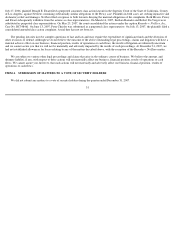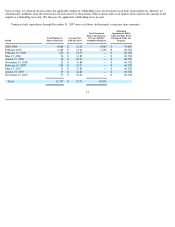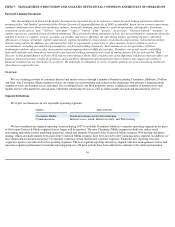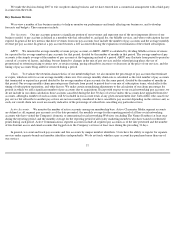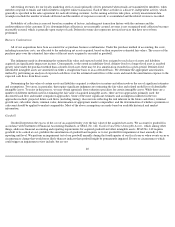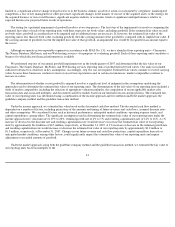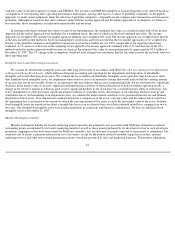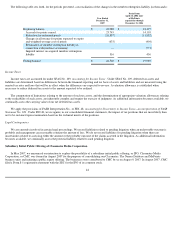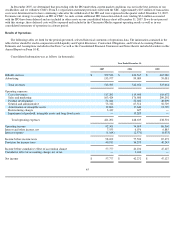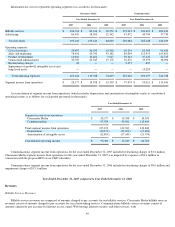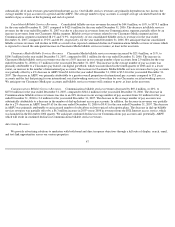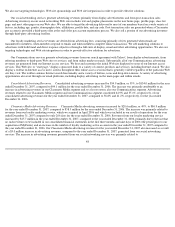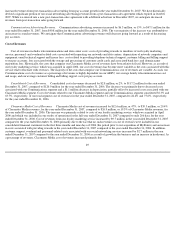Classmates.com 2007 Annual Report Download - page 43
Download and view the complete annual report
Please find page 43 of the 2007 Classmates.com annual report below. You can navigate through the pages in the report by either clicking on the pages listed below, or by using the keyword search tool below to find specific information within the annual report.
limited to, a significant adverse change in legal factors or in the business climate, an adverse action or assessment by a regulator, unanticipated
competition, a loss of key management or other personnel, significant changes in the manner of our use of the acquired assets or the strategy for
the acquired business or our overall business, significant negative industry or economic trends or significant underperformance relative to
expected historical or projected future results of operations.
The testing for a potential impairment of goodwill involves a two-step process. The first step of the impairment test involves comparing the
estimated fair values of each of our reporting units with their respective net book values, including goodwill. If the estimated fair value exceeds
net book value, goodwill is considered not to be impaired and no additional steps are necessary. If, however, the estimated fair value of the
reporting unit is less than net book value, including goodwill, then the carrying amount of the goodwill is compared with its implied fair value. If
the carrying amount of goodwill exceeds the implied fair value of that goodwill, an impairment loss would be recognized in an amount equal to
the excess.
Although we operate in two reportable segments in accordance with SFAS No. 131, we have identified four reporting units—Classmates,
The Names Database, MyPoints, and our Web hosting services—for purposes of evaluating goodwill. Each of these reporting units constitutes a
business for which discrete financial information is available.
We performed step one of our annual goodwill impairment test in the fourth quarter of 2007 and determined that the fair value of our
Classmates, The Names Database, MyPoints, and Web hosting services reporting units exceeded their net book values. Our analysis included
sufficient tolerance for sensitivity in key assumptions. Accordingly, step two was not required. Estimated fair values continue to exceed carrying
values because these businesses continue to meet or exceed our expectations and, in certain circumstances, market comparables continue to
increase in values.
The determination of whether or not goodwill is impaired involves a significant level of judgment in the assumptions underlying the
approaches used to determine the estimated fair value of our reporting units. The determination of the fair value of our reporting units included a
study of market comparables, including the selection of appropriate valuation multiples, the compilation of recent applicable market sales
transaction data and associated multiples, and discounted cash flow models based on our internal forecasts and projections. The estimated fair
value of our reporting units was determined using a combination of the income approach and two methods under the market approach: the
guideline company method and the guideline transaction method.
Under the income approach, we estimated fair value based on the discounted cash flow method. The discounted cash flow method is
dependent on a number of factors, including projections of the amounts and timing of future revenues and cash flows, assumed discount rates
and other assumptions. We considered factors such as historical performance, anticipated market conditions, operating expense trends, and
capital expenditures, among others. The significant assumptions used in determining the estimated fair value of our reporting units under the
income approach were: discount rate of 19% to 20%, terminal growth rate of 4% to 5% and resulting capitalization rate of 14% to 16%. A 1%
increase or decrease in the discount rate and resulting capitalization rate would decrease or increase the estimated fair value of our reporting
units by approximately $6.4 million or $6.5 million, respectively, at December 31, 2007. A 1% increase or decrease in the terminal growth rate
and resulting capitalization rate would increase or decrease the estimated fair value of our reporting units by approximately $1.2 million or
$1.3 million, respectively, at December 31, 2007. Changes in our future revenue and cash flow projections, capital expenditure forecasts or
anticipated market conditions, among other factors, could significantly impact the estimated fair value of our reporting units and require
adjustments to recorded amounts of goodwill.
Under the market approach, using both the guideline company method and the guideline transaction method, we estimated the fair value of
our reporting units based on multiples of the
41


